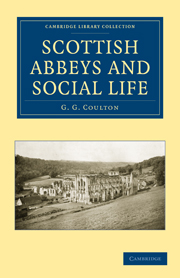Book contents
- Frontmatter
- Contents
- LIST OF ILLUSTRATIONS
- Preface
- Chapter I Celtic Monachism
- Chapter II The Monastic Rules
- Chapter III Monastic Revenues
- Chapter IV How Endowments Came (I)
- Chapter V How Endowments Came (II)
- Chapter VI Monks and Parishes (I)
- Chapter VII Monks and Parishes (II)
- Chapter VIII Charity (I)
- Chapter IX Charity (II)
- Chapter X Monk and Peasant (I)
- Chapter XI Monk and Peasant (II)
- Chapter XII Monastic Housekeeping
- Chapter XIII Church and Scriptorium
- Chapter XIV The Monastic Chronicler
- Chapter XV Schools
- Chapter XVI Art and Learning
- Chapter XVII Professions and Business
- Chapter XVIII Visitation (I)
- Chapter XIX Visitation (II)
- Chapter XX A Voice from the Cloister
- Chapter XXI Conclusion
- Appendixes
- List of Authorities
- Index
Chapter IX - Charity (II)
Published online by Cambridge University Press: 05 August 2011
- Frontmatter
- Contents
- LIST OF ILLUSTRATIONS
- Preface
- Chapter I Celtic Monachism
- Chapter II The Monastic Rules
- Chapter III Monastic Revenues
- Chapter IV How Endowments Came (I)
- Chapter V How Endowments Came (II)
- Chapter VI Monks and Parishes (I)
- Chapter VII Monks and Parishes (II)
- Chapter VIII Charity (I)
- Chapter IX Charity (II)
- Chapter X Monk and Peasant (I)
- Chapter XI Monk and Peasant (II)
- Chapter XII Monastic Housekeeping
- Chapter XIII Church and Scriptorium
- Chapter XIV The Monastic Chronicler
- Chapter XV Schools
- Chapter XVI Art and Learning
- Chapter XVII Professions and Business
- Chapter XVIII Visitation (I)
- Chapter XIX Visitation (II)
- Chapter XX A Voice from the Cloister
- Chapter XXI Conclusion
- Appendixes
- List of Authorities
- Index
Summary
It may, I think, be safely affirmed that, the more carefully we study the available records, the more easily we understand why monastic almsgiving ceased to be an indispensable factor in later medieval society; and why the lay authorities, in every state, have approached the problem from a different angle. There is still much room for improvement, of course; but it seems historically impossible to maintain that the poor were better cared for in the four centuries before the Reformation than in the four centuries since.
Doubtless one cause of the decay of monastic charity was pecuniary embarrassment. The monks were certainly more business-like, on the whole, than the average lay lord; but that is not saying much. As early as the thirteenth century, at least, disciplinarians had to insist that there must be better keeping and auditing of accounts. A great mass of episcopal visitations and similar documents have survived, in different countries, for the three generations before the Reformation; all these show frequent financial carelessness or irregularity; there were even great abbeys at which accounts were never presented to the community, and could not be produced at the demand of the visitors. Moreover, in a comparatively lawless society, the known wealth of the monks often exposed them to robbery or extortion. In these circumstances, the houses sank deeper and deeper into debt, or balanced their budget only by diminishing the number of brethren and shirking other financial commitments. The problem was rendered more acute by the growing abuse of private property.
- Type
- Chapter
- Information
- Scottish Abbeys and Social Life , pp. 110 - 118Publisher: Cambridge University PressPrint publication year: 2010First published in: 1933

